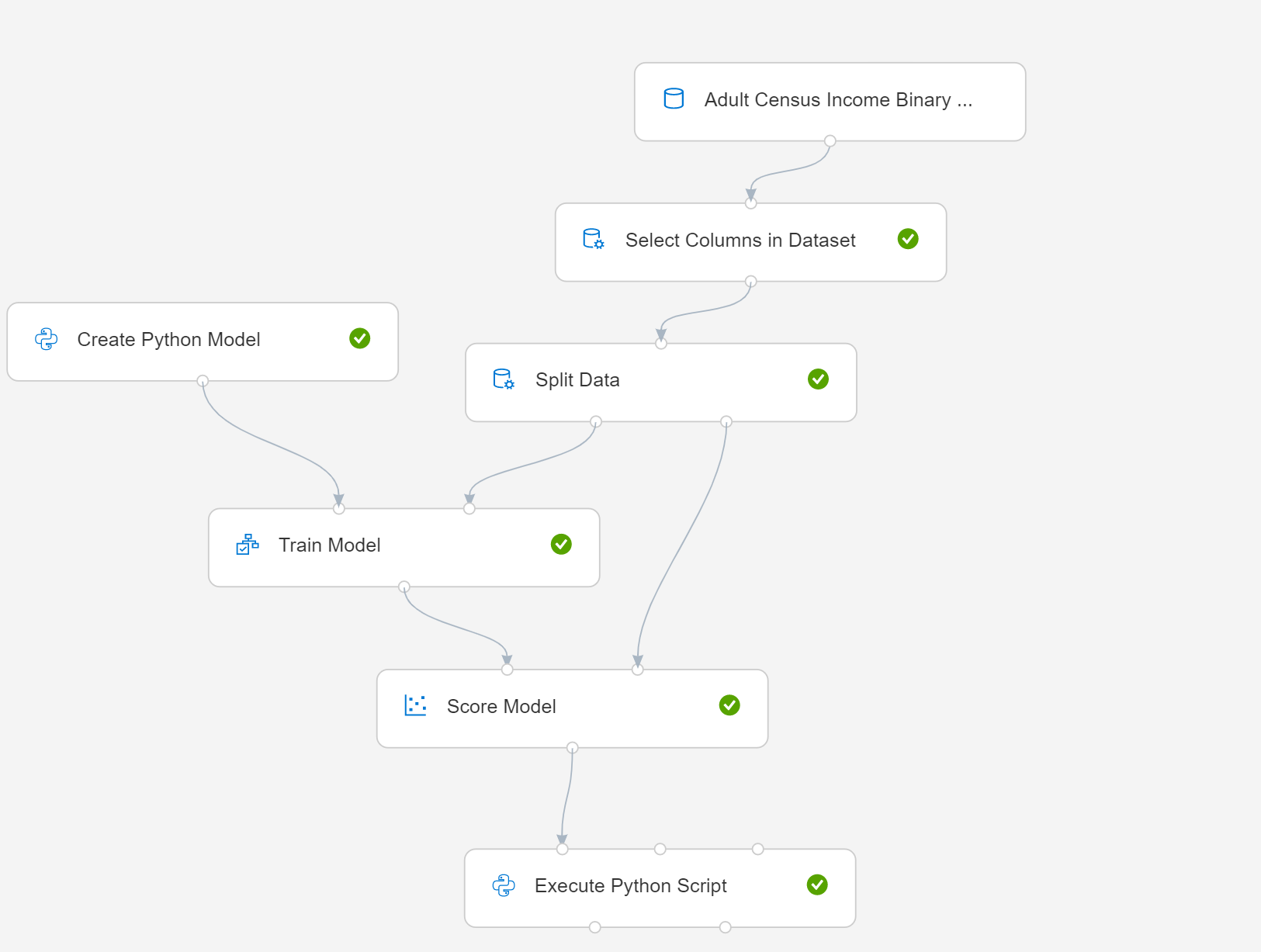Create Python Model component
This article describes a component in Azure Machine Learning designer.
Learn how to use the Create Python Model component to create an untrained model from a Python script. You can base the model on any learner that's included in a Python package in the Azure Machine Learning designer environment.
After you create the model, you can use Train Model to train the model on a dataset, like any other learner in Azure Machine Learning. The trained model can be passed to Score Model to make predictions. You can then save the trained model and publish the scoring workflow as a web service.
Warning
Currently, it's not possible to connect this component to Tune Model Hyperparameters component or pass the scored results of a Python model to Evaluate Model. If you need to tune the hyperparameters or evaluate a model, you can write a custom Python script by using Execute Python Script component.
Configure the component
Use of this component requires intermediate or expert knowledge of Python. The component supports use of any learner that's included in the Python packages already installed in Azure Machine Learning. See the preinstalled Python package list in Execute Python Script.
Note
Please be very careful when writing your script and makes sure there is no syntax error, such as using a un-declared object or a un-imported component.
Note
Also pay extra attentions to the pre-installed components list in Execute Python Script. Only import pre-installed components. Please do not install extra packages such as "pip install xgboost" in this script, otherwise errors will be raised when reading models in down-stream components.
This article shows how to use Create Python Model with a simple pipeline. Here's a diagram of the pipeline:

- Select Create Python Model, and edit the script to implement your modeling or data management process. You can base the model on any learner that's included in a Python package in the Azure Machine Learning environment.
Note
Please pay extra attention to the comments in sample code of the script and make sure your script strictly follows the requirement, including the class name, methods as well as method signature. Violation will lead to exceptions. Create Python Model only supports creating sklearn based model to be trained using Train Model.
The following sample code of the two-class Naive Bayes classifier uses the popular sklearn package:
# The script MUST define a class named Azure Machine LearningModel.
# This class MUST at least define the following three methods:
# __init__: in which self.model must be assigned,
# train: which trains self.model, the two input arguments must be pandas DataFrame,
# predict: which generates prediction result, the input argument and the prediction result MUST be pandas DataFrame.
# The signatures (method names and argument names) of all these methods MUST be exactly the same as the following example.
# Please do not install extra packages such as "pip install xgboost" in this script,
# otherwise errors will be raised when reading models in down-stream components.
import pandas as pd
from sklearn.naive_bayes import GaussianNB
class AzureMLModel:
def __init__(self):
self.model = GaussianNB()
self.feature_column_names = list()
def train(self, df_train, df_label):
# self.feature_column_names records the column names used for training.
# It is recommended to set this attribute before training so that the
# feature columns used in predict and train methods have the same names.
self.feature_column_names = df_train.columns.tolist()
self.model.fit(df_train, df_label)
def predict(self, df):
# The feature columns used for prediction MUST have the same names as the ones for training.
# The name of score column ("Scored Labels" in this case) MUST be different from any other columns in input data.
return pd.DataFrame(
{'Scored Labels': self.model.predict(df[self.feature_column_names]),
'probabilities': self.model.predict_proba(df[self.feature_column_names])[:, 1]}
)
Connect the Create Python Model component that you just created to Train Model and Score Model.
If you need to evaluate the model, add an Execute Python Script component and edit the Python script.
The following script is sample evaluation code:
# The script MUST contain a function named azureml_main # which is the entry point for this component. # imports up here can be used to import pandas as pd # The entry point function MUST have two input arguments: # Param<dataframe1>: a pandas.DataFrame # Param<dataframe2>: a pandas.DataFrame def azureml_main(dataframe1 = None, dataframe2 = None): from sklearn.metrics import accuracy_score, precision_score, recall_score, roc_auc_score, roc_curve import pandas as pd import numpy as np scores = dataframe1.ix[:, ("income", "Scored Labels", "probabilities")] ytrue = np.array([0 if val == '<=50K' else 1 for val in scores["income"]]) ypred = np.array([0 if val == '<=50K' else 1 for val in scores["Scored Labels"]]) probabilities = scores["probabilities"] accuracy, precision, recall, auc = \ accuracy_score(ytrue, ypred),\ precision_score(ytrue, ypred),\ recall_score(ytrue, ypred),\ roc_auc_score(ytrue, probabilities) metrics = pd.DataFrame(); metrics["Metric"] = ["Accuracy", "Precision", "Recall", "AUC"]; metrics["Value"] = [accuracy, precision, recall, auc] return metrics,
Next steps
See the set of components available to Azure Machine Learning.